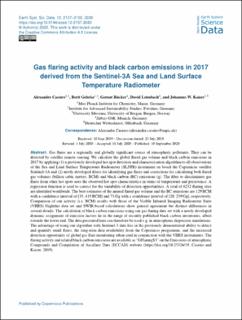| dc.contributor.author | Caseiro, Alexandre | |
| dc.contributor.author | Gehrke, Berit | |
| dc.contributor.author | Rücker, Gernot | |
| dc.contributor.author | Leimbach, David | |
| dc.contributor.author | Kaiser, Johannes W. | |
| dc.date.accessioned | 2021-05-11T13:46:38Z | |
| dc.date.available | 2021-05-11T13:46:38Z | |
| dc.date.created | 2020-09-15T13:49:51Z | |
| dc.date.issued | 2020 | |
| dc.Published | Earth System Science Data. 2020, 12 2137-2155. | |
| dc.identifier.issn | 1866-3508 | |
| dc.identifier.uri | https://hdl.handle.net/11250/2754985 | |
| dc.description.abstract | Gas flares are a regionally and globally significant source of atmospheric pollutants. They can be detected by satellite remote sensing. We calculate the global flared gas volume and black carbon emissions in 2017 by applying (1) a previously developed hot spot detection and characterisation algorithm to all observations of the Sea and Land Surface Temperature Radiometer (SLSTR) instrument on board the Copernicus satellite Sentinel-3A and (2) newly developed filters for identifying gas flares and corrections for calculating both flared gas volumes (billion cubic metres, BCM) and black carbon (BC) emissions (g). The filter to discriminate gas flares from other hot spots uses the observed hot spot characteristics in terms of temperature and persistence. A regression function is used to correct for the variability of detection opportunities. A total of 6232 flaring sites are identified worldwide. The best estimates of the annual flared gas volume and the BC emissions are 129 BCM with a confidence interval of [35, 419 BCM] and 73 Gg with a confidence interval of [20, 239 Gg], respectively. Comparison of our activity (i.e. BCM) results with those of the Visible Infrared Imaging Radiometer Suite (VIIRS) Nightfire data set and SWIR-based calculations show general agreement but distinct differences in several details. The calculation of black carbon emissions using our gas flaring data set with a newly developed dynamic assignment of emission factors lie in the range of recently published black carbon inventories, albeit towards the lower end. The data presented here can therefore be used e.g. in atmospheric dispersion simulations. The advantage of using our algorithm with Sentinel-3 data lies in the previously demonstrated ability to detect and quantify small flares, the long-term data availability from the Copernicus programme, and the increased detection opportunity of global gas flare monitoring when used in conjunction with the VIIRS instruments. The flaring activity and related black carbon emissions are available as “GFlaringS3” on the Emissions of atmospheric Compounds and Compilation of Ancillary Data (ECCAD) website (https://doi.org/10.25326/19, Caseiro and Kaiser, 2019). | en_US |
| dc.language.iso | eng | en_US |
| dc.rights | Navngivelse 4.0 Internasjonal | * |
| dc.rights.uri | http://creativecommons.org/licenses/by/4.0/deed.no | * |
| dc.title | Gas flaring activity and black carbon emissions in 2017 derived from the Sentinel-3A Sea and Land Surface Temperature Radiometer | en_US |
| dc.type | Journal article | en_US |
| dc.type | Peer reviewed | en_US |
| dc.description.version | publishedVersion | en_US |
| dc.rights.holder | Copyright 2020 The Authors | en_US |
| cristin.ispublished | true | |
| cristin.fulltext | original | |
| cristin.qualitycode | 1 | |
| dc.identifier.doi | 10.5194/essd-12-2137-2020 | |
| dc.identifier.cristin | 1830088 | |
| dc.source.journal | Earth System Science Data | en_US |
| dc.source.40 | 12 | |
| dc.source.pagenumber | 2137-2155 | en_US |
| dc.identifier.citation | Earth System Science Data. 2020, 12, 2137–2155 | en_US |
| dc.source.volume | 12 | en_US |

